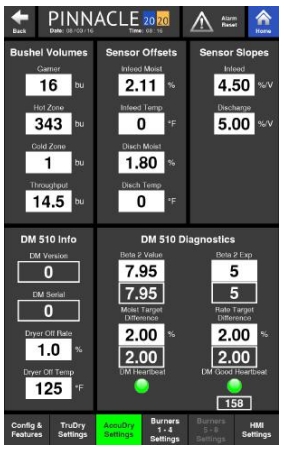AccuDry Settings
The third button under the Service page is the AccuDry Settings page. This page displays the critical values for the AccuDry system to operate effectively.

Bushel Volumes
In this tile, the Garner, Hot Zone Volume, and Cold Zone indicate how many bushels are contained in those parts of the dryer. The Throughput is the speed the dryer needs to run at in order to move the grain currently at the infeed moisture sensor, to the discharge moisture sensor, in exactly 1 hour. These values are dryer specific, and the AccuDry system uses these values to best determine the rate at which the dryer should be operating. These values also play a crucial role in how the AccuDry predicted moisture value is calculated. Although these values can be input manually they are automatically generated when the Dryer Series and Model are selected on the Configuration & Features page.
Sensor Offsets and Sensor Slopes
These tiles are where trained service technicians can manually adjust the DM sensor values. The two values that calculate the moistures are the slope and offset values. The voltage measured by the sensor is mutiplied by the slope and then added to the the offest value of the sensor, resulting in a % moisture value. Here, the technician can save time by manually adjusting the slope (not recommended) and/or offset value (preferred) in order to alleviate the need to calibrate multiple times upon initial setup, due to the 0.5% restriction placed on normal calibration routines. The technician may simply enter the desired offset with a single touch of the button, eliminating the need to calibrate several times.
DM 510 Info
This tile contains the DM version and serial number of the DM board installed on the dryer. In addition to this are two adjustable values; Dryer Off Rate and Dryer Off Temp.
Dryer Off Rate
This is the minimum rate at which the dryer will operate, and it is recommended to remain at 1.0%. This parameter is used to signal the DM510 that the dryer is not discharging and should not be taking any more data. If this is different than the Minimum Operational Discharge Rate, then there is a risk that the system will be calculating dryer operations while shutdown; hurting the overall re-startup time for the next drying run. If this parameter is modified, it is strongly urged that a Mathews Company Engineer or Mathews Company Service Technician is consulted before doing so.
Dryer Off Temp
This is used by the DM 510 board in determining whether a plenum is considered a heat zone or cool zone. If the actual plenum temperature is lower than this value, the plenum is considered a cool zone. If the actual plenum temperature is higher than this value, the plenum is considered a heat zone. If the average of the plenum temperatures is under the value entered, the system will not be learning, therefore AccuDry will not be able to be enabled.
DM 510 Diagnostics
This tile offers even more information on the DM 510 board including the following:
Beta2 Value & Exp
Feedback from the sensors comparing the predicted moistures versus the actual measured values. This feedback determines how the dryer will control the discharge speed, and should not be modified.
Target difference
This is the maximum allowed deviation between the actual and predicted values can vary before AccuDry can be enabled. For instance, if the Moist Target Difference is 2.00%, the actual discharge moisture must be within 2.00% of the predicted discharge moisture before AccuDry can be enabled.
Rate Targe Difference
This is the maximum allowed deviation between the actual and suggested rate before AccuDry can be enabled. If the Rate Target Difference is 5.00%, the actual discharge rate must be within 5.00% of the suggested discharge rate in order for AccuDry to be enabled.
DM Heart Beat
This indicator light will blink green when the DM Board is communicating with the PLC.
DM Good Heartbeat
This will illuminate green when the communication between the DM Board and PLC is sensed an adequate number of times within a minute.
